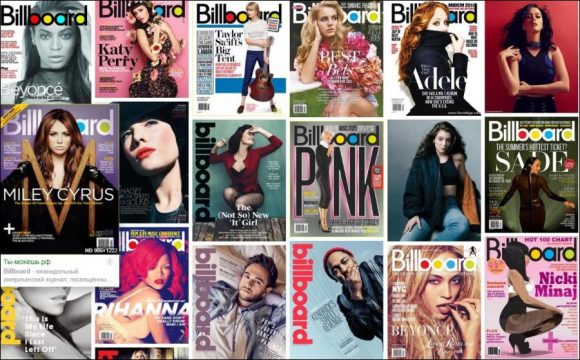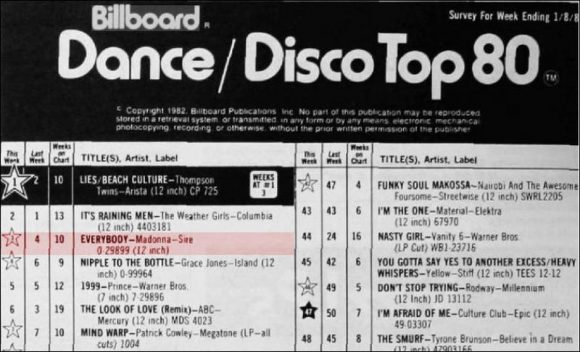The Dance Club Songs chart is a weekly chart published exclusively by Billboard in the United States. It is a national survey of the songs which are the most popular in nightclubs across the country and is compiled from reports from a national sample of disc jockeys.[1] It was launched as the Disco Action Top 30 chart on August 28, 1976, and became the first chart by Billboard to document the popularity of dance music.
Since its inception, several artists have set various records and garnered multiple achievements. In January 2017, Billboard proclaimed Madonna as the most successful artist in the history of the chart, ranking her first in their list of the 100 top all time dance artists and Janet Jackson being the second most successful dance club artist of all-time; Madonna also holds the record for the most number-one songs, with 48.
Katy Perry holds the record for having eighteen consecutive number-one songs. Perry’s third studio album, Teenage Dream (2010), became the first album in the history of the chart to produce at least seven number-one songs between 2010–12, a record it held solely until Rihanna’s eighth studio album Anti produced eight chart toppers through 2016-17. Rihanna is the only artist to have achieved five number-one songs in a calendar year.
The first number-one song on the Dance Club Songs chart for the issue dated August 28, 1976, was “You Should Be Dancing” by the Bee Gees; it spent five weeks atop the chart and was the group’s only number-one song. The current number-one song on the Dance Club Songs chart for the issue dated September 14, 2019, is “If You Love Somebody Set Them Free 2019” by Sting.
A Brief History
Dance Club Songs has undergone several incarnations since its inception in 1974. Originally a top-ten list of tracks that garnered the largest audience response in New York City discothèques, the chart began on October 26, 1974 under the title Disco Action. The chart went on to feature playlists from various cities around the country from week to week.
Billboard continued to run regional and city-specific charts throughout 1975 and 1976 until the issue dated August 28, 1976, when a thirty-position National Disco Action Top 30 premiered. This quickly expanded to forty positions, then in 1979 the chart expanded to sixty positions, then eighty, and eventually reached 100 positions from 1979 until 1981, when it was reduced to eighty again.
During the first half of the 1980s the chart maintained eighty slots until March 16, 1985 when the Disco charts were splintered and renamed. Two charts appeared: Hot Dance/Disco, which ranked club play (fifty positions), and Hot Dance Music/Maxi-Singles Sales, which ranked 12-inch single (or maxi-single) sales (also fifty positions, now reduced to ten and available through Billboard.biz only).
Only Hot Dance Club Songs still exists today. In 2003 Billboard introduced the Hot Dance Airplay chart (now known as Dance/Mix Show Airplay), which is based solely on radio airplay of six dance music stations and top 40 mix shows electronically monitored by Nielsen Broadcast Data Systems.[10] These stations are also a part of the electronically monitored panel that encompasses the Hot 100.
On January 26, 2013, Billboard added a new chart, Dance/Electronic Songs, which tracks the 50 most popular Dance and Electronic singles and tracks based on digital single sales, streaming, radio airplay, and club play as reported on the component Dance/Electronic Digital Songs, Dance/Electronic Streaming Songs, and Dance Club Songs charts. Radio airplay is not limited to that counted on the Dance/Mix Show Airplay chart.
Although the disco chart began reporting popular songs in New York City nightclubs, Billboard soon expanded coverage to feature multiple charts each week which highlighted playlists in various cities such as San Francisco, San Diego, Boston, Los Angeles, Miami, Phoenix, Detroit and Houston (among others).
During this time, Billboard rival publication Record World was the first to compile a dance chart which incorporated club play on a national level. Noted Billboard statistician Joel Whitburn has since “adopted” Record Worlds chart data from the weeks between March 29, 1975 and August 21, 1976 into Billboards club play history.
For the sake of continuity, Record Worlds national chart is incorporated into both Whitburn’s Dance/Disco publication (via his Record Research company) as well as the 1975 and 1976 number-ones lists. With the issue dated August 28, 1976, Billboard premiered its own national chart (National Disco Action Top 30) and their data is used from this date forward.
Visits: 1131




